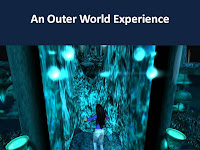It involved an international community of counsellors interested in:
- Using virtual worlds as a delivery platform to present counselling related topics (not necessarily involving virtual worlds) to an international community, without the time and cost factors involved in international travel;
- Exploring the role virtual worlds do or could play in:
- Counsellor education
- Continuing professional development
- Networking
- Formal meetings of various counselling related groups
- Sharing of a range of resources:
- In-world tools
- Journals
- Books
- Workshop materials
- Exploring the ethical issues relevant to changing technology and therapy
A PDF file of the 3VCC Worshop Abstracts can be viewed at: http://sl.counseloreducation.org/resources/3vcc-Program.pdf
Also have a look at John Wilson's videos http://www.onlinevents.co.uk/index.html . John also has a service where people can observe the vitual web events as a live video without participants having to come in as an avatar in-world.
John also has a YouTube Channel you may wish to explore: http://www.youtube.com/user/wilsoncounselling.
Stay tuned, some video extracts from the 3VCC are on their way.




































